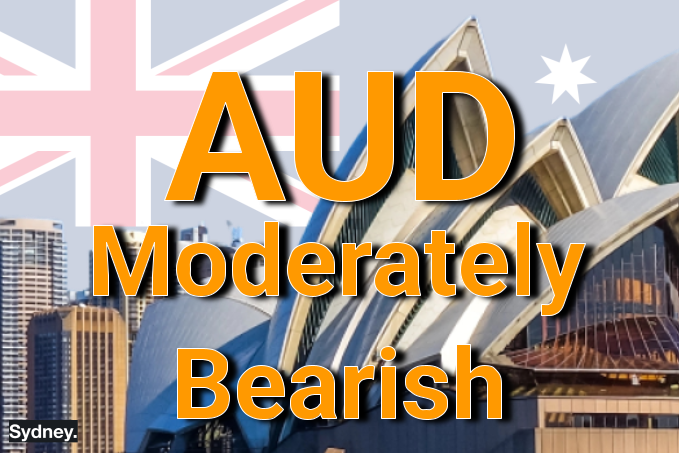AUD Fundamental Value
the fair value of the AUD is to see a moderately bearish influence
AUD to see a moderately bearish influence upon its fair value
It looks like the AUD might face a bit of a headwind over the next couple of months. Basically, the Aussie dollar is caught between what's happening at home and the big stuff playing out globally.
Over the next seven weeks or so, the main issue seems to be this: folks really expect the Reserve Bank of Australia (RBA) to cut interest rates, probably in May. Why? Mostly because there are worries about how the whole US-China trade spat could slow down the global economy. An expected rate cut tends to weigh on a currency.
At the same time, everyone's got their eyes glued on China. How's their economy really doing? Is the government's stimulus actually helping? This matters hugely because Australia sells a ton of stuff to China, especially iron ore (which, funnily enough, has been holding up pretty well lately).
So, the key things steering the Aussie dollar will likely be:
What the RBA does with interest rates.
How the US-China trade situation develops and how that makes markets feel overall.
The actual strength of China's economy.
Where commodity prices like iron ore go from here.
Trade Issues and Government Moves
Whenever you look at the Australian government's situation and finances, it keeps coming back to that US-China trade fight. People are watching closely how the Australian government navigates the tricky diplomatic situation and any economic bumps, especially if key exports like iron ore take a hit, hurting tax income. And again, whether China's stimulus efforts successfully boost demand is a really important part of the picture.
Australia is a federal parliamentary constitutional monarchy, currently led by the Labor Party's Prime Minister Anthony Albanese and Treasurer Jim Chalmers. They're focused on managing the economy, cost of living, finding new trade deals, and the green energy shift.
What to Watch For (Gov & Trade)
Looking ahead, the main thing is how the Australian government responds to the global trade scene and any economic effects at home. A big question is whether China's stimulus plans (like selling bonds and funding infrastructure) will actually lead to solid, ongoing demand for Australian commodities – that's crucial for Australia's budget.
What Just Happened?
Recently, Australia criticized US tariffs but held off on hitting back directly, preferring talks. China, meanwhile, boosted its economic support with things like higher budget spending early in the year and strong credit growth in March, trying to shield its economy. It's worth noting, though, that Fitch Ratings recently got a bit more cautious about China's credit rating, pointing specifically to trade tension worries and government finances. China also kept pushing back against US trade actions.
Australia's Economy vs. Global Pressures
The core story here is Australia's own economic strength bumping up against the big cloud cast by the US-China trade fight over global growth. How China's economy performs and its demand for commodities (especially iron ore) are still super critical for Australia's economy and the AUD.
Australia has a strong, resource-rich economy relying a lot on services and trade. Exports like iron ore and coal are key, along with farming and education. Its big trading partners are China, Japan, South Korea, and the US. Think big miners like BHP, Rio Tinto, Fortescue, major banks (Commonwealth, Westpac, NAB, ANZ), and healthcare giant CSL. The main stock market index is the S&P/ASX 200.
What to Watch For (Economy)
Keep an eye on upcoming Australian numbers like the March trade balance (due May 1st) and the April business confidence survey (around May 13th) for updates on the local scene. From China, manufacturing PMI data (May 1st) and April activity numbers (like industrial output and retail sales) will be important clues about demand for Aussie goods. And obviously, keep tracking iron ore prices and Chinese steel production.
What Just Happened (Economy)?
Recent data has been a bit of a mixed bag. Australia had decent growth late last year and okay business activity signals in March, but lost jobs unexpectedly in February, and inflation cooled off faster than forecast. China's data was also patchy: strong factory output early on and a March export jump, but weak imports, ongoing worries about prices falling (deflation), and problems in the property market wouldn't go away. Interestingly, iron ore prices stayed pretty strong through late April, seemingly boosted by hopes for Chinese stimulus, even though coal prices were weak. Shipping costs (the Baltic Dry Index) bounced around, showing uncertain demand signals.
Central Banks: RBA Cutting vs. China Supporting
Right now, different paths for interest rates are really driving market feelings. Pretty much everyone thinks the RBA will cut rates in May because of global risks and slowing inflation at home – and that's putting pressure on the AUD. Compare that to China's central bank (the PBoC), which keeps signalling it will support its economy to fight off trade headwinds.
The RBA (Governor Michele Bullock) independently targets inflation (2-3%), full employment, and general economic health.
What to Watch For (Central Banks)
The RBA's meeting on May 20th is the big one – markets heavily expect a 0.25% rate cut. What they say in their statement will be just as important for figuring out what comes next.
What Just Happened (Central Banks)?
At its April meeting, the RBA kept rates on hold but importantly, dropped some cautious phrases it had used before about easing policy further. Markets saw that as a subtle hint they were leaning towards cutting. Later data showing weaker jobs and softer inflation just reinforced the idea of a May cut. China's PBoC, on the other hand, kept its main lending rates steady in April but did pump a lot of cash into the banking system and Governor Pan repeated the bank's supportive position, specifically mentioning worries about global trade. Strong loan growth numbers from China in March also suggested earlier stimulus was having some effect.
Caught in the Middle: Trade Worries Rule
The Aussie dollar really gets bounced around by how optimistic or pessimistic investors are feeling globally ("risk appetite"), and right now, that's almost all about the unpredictable US-China trade situation. Anything that changes views on global growth, especially news about China's demand for commodities, tends to hit the AUD directly.
The AUD is usually seen as a 'risk-on' currency – it does well when investors feel good about the world and struggles when they're scared. It often moves with commodity prices (especially iron ore) and is tightly linked to how China's doing. Money flows in and out based on interest rate differences, overall market mood, and foreign investment.
What to Watch For (Risk & Trade)
You've got to stay glued to the news on US-China trade talks, any new tariffs, and what officials are saying. How markets react to big global economic reports, especially upcoming US growth (GDP), inflation (PCE), and jobs (NFP) numbers, will heavily influence risk sentiment and could really move the AUD. Also, watching those speculative positioning reports (CFTC) can give clues.
What Just Happened (Risk & Trade)?
The last seven weeks were wild, with huge swings in US trade policy – tariffs announced, put in place, paused for some countries, then ramped up hard against China. The AUD reacted sharply, getting brief boosts when it looked like Australia might be spared, but mostly feeling the heat from fears that a global slowdown would hurt its biggest customer, China. China, of course, retaliated with its own tariffs. All this uncertainty pushed money into safe havens and away from riskier currencies like the AUD at times. It even led Fitch Ratings to lower its outlook on China's government debt, specifically because of the trade risks.
So, What's the Bottom Line for Traders?
Summing it up, the Australian dollar looks like it's walking a bit of a tightrope over the next few weeks, and the pressure seems tilted slightly downwards. The widely expected RBA rate cut is a key factor weighing on it from home.
But the really big driver is still external: the unpredictable US-China trade saga. That's going to keep causing market swings, affecting overall risk mood, and – crucially for Australia – impacting demand for its commodities. You need to watch China's economic health very closely – is their stimulus strong enough to offset the trade problems?
For anyone trading the AUD, this means staying hyper-aware of trade headlines, key Chinese data, and definitely iron ore prices. While the RBA's May 20th decision is important, the tone of their statement might be just as telling as the rate cut itself. Given how sensitive the AUD is to risk and commodity news, be ready for potentially sharp moves and maybe think about having good risk management strategies in place, especially around big data releases or sudden trade news.





